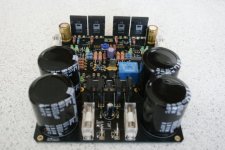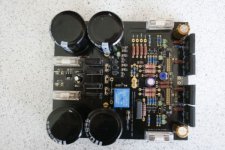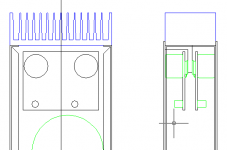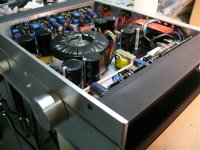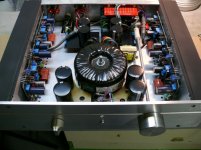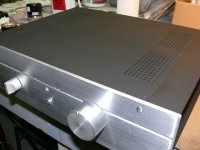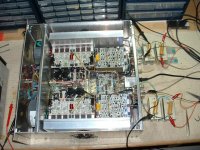The Saint said:
Here is my latest Amplifier module
Amplifier, loudspeaker protection and power supply all on the same PCB.
...
Nice... really nice job Anthony!
I want one!

Cheers!
Hi dudaindc
Thanks!
The PCB has 3 ounce copper with gold immersion tracks, PTH and pads.
There is also a connection on the pcb for a thermal switch, if used
it will activate the speaker protection and turn off the loudspeaker
The loudspeaker protection also has a 4 sec turn on delay, but at mains supply turn off it senses the AC drop out and turns off the loudspeaker straight away.
The amplifier also features Balanced inputs as well as un-balanced
Power outputs range from as low as 100 watts to 500 watts
depending on the type of devices used. either single die laterals or dual die laterals, all n channel output stage.
I will be doing a feature on this latest module on my web site soon.
At the moment I only have 2 of the modules made and they have been sold to an amplifier company in Western Australia to try out
as a multi channel amplifier for HT.
I hope to have some more boards manufactured before christmas
and make these modules available in Jan 2008
Thanks!
The PCB has 3 ounce copper with gold immersion tracks, PTH and pads.
There is also a connection on the pcb for a thermal switch, if used
it will activate the speaker protection and turn off the loudspeaker
The loudspeaker protection also has a 4 sec turn on delay, but at mains supply turn off it senses the AC drop out and turns off the loudspeaker straight away.
The amplifier also features Balanced inputs as well as un-balanced
Power outputs range from as low as 100 watts to 500 watts
depending on the type of devices used. either single die laterals or dual die laterals, all n channel output stage.
I will be doing a feature on this latest module on my web site soon.
At the moment I only have 2 of the modules made and they have been sold to an amplifier company in Western Australia to try out
as a multi channel amplifier for HT.
I hope to have some more boards manufactured before christmas
and make these modules available in Jan 2008
Banned
Joined 2002
The Saint said:and yet another
VERY NICE Anthony, i like that a-lot, i think i should buy a pair, any prices ?
Banned
Joined 2002
The Saint said:Hi Jason
Thanks mate!
I sold these modules for $450.00AUD each
In Canadian dollars that works out to be $390.00CAD each
or €290.00 Euro each.
Can I put you on the list for a pair?
Can you post some more specs what type of amp class a or ab? Power raiting,
Is that fully built except transformer, what is the rail voltage, what transformer is needed ect ect
Thanks.
Jase
Hi Jason
Yes the price quoted is fully assembled and tested.
The modules are capable of power outs as high as 500 watts RMS into 4 Ohms.
But for most people a couple of hundred watts into 8 Ohm is all
they would need.
If that was the case then a 400va transformer with 50Vac + 50Vac secondary windings would be just right for each channel.
Frequency Response:5hz - 200khz
Power Bandwidth: 100khz
THD:0.02%
Noise: -120dB
Damping Factor 400
Input Impedance 34k Ohms
Input sensitivity for full power out into 8 Ohm load 1 Volt
The sound quality from these modules is awesome...
Yes the price quoted is fully assembled and tested.
The modules are capable of power outs as high as 500 watts RMS into 4 Ohms.
But for most people a couple of hundred watts into 8 Ohm is all
they would need.
If that was the case then a 400va transformer with 50Vac + 50Vac secondary windings would be just right for each channel.
Frequency Response:5hz - 200khz
Power Bandwidth: 100khz
THD:0.02%
Noise: -120dB
Damping Factor 400
Input Impedance 34k Ohms
Input sensitivity for full power out into 8 Ohm load 1 Volt
The sound quality from these modules is awesome...
My latest class-A amp.
Power follower using IRFP450 and LM317 as CCS. ( switchable bias 1, 2 or 3A using one LM317/amp)
Layout of one channel:
/R
Power follower using IRFP450 and LM317 as CCS. ( switchable bias 1, 2 or 3A using one LM317/amp)
Layout of one channel:
An externally hosted image should be here but it was not working when we last tested it.
/R
Inside:
PSU using 2x24V/300VA, 13000uF - 2.2uH - 26000uF.
Have abt. 31V DC under full load.

Casing:
PSU using 2x24V/300VA, 13000uF - 2.2uH - 26000uF.
Have abt. 31V DC under full load.

Casing:
An externally hosted image should be here but it was not working when we last tested it.
I finally got around to taking a photo of my 50W lateral MOSFET amp, that I'm using in my study, to drive a pair of Vifa P13WH based two-way speakers:
It's a single-pair iteration of my 100W amp, which is in turn a re-spin of David Tilbrook's AEM6000 amplifier, from way back in '87.
Performance is very nice - after some false starts getting the boards going. THD is around 0.002% at 1KHz, driving 50W into 8 Ohms. There's actually a pair of monoblocks crammed in the case, one atop the other, mounted to a length of aluminium extrusion, which is in turn mounted to the heatsink. The transformer is a dual 25V, 160VA one.
It's fairly compact, about the size of a shoebox. I designed it to fit atop my PC. The case is simply folded from sheet aluminium.
I'm quite happy with it. It sounds really nice, just like its 100W big brother. Clean and transparent, with oodles of power. It's a nice match for the little 5" speakers I'm driving with it. Certainly plenty of amplifier for my study, at any rate.
An externally hosted image should be here but it was not working when we last tested it.
It's a single-pair iteration of my 100W amp, which is in turn a re-spin of David Tilbrook's AEM6000 amplifier, from way back in '87.
Performance is very nice - after some false starts getting the boards going. THD is around 0.002% at 1KHz, driving 50W into 8 Ohms. There's actually a pair of monoblocks crammed in the case, one atop the other, mounted to a length of aluminium extrusion, which is in turn mounted to the heatsink. The transformer is a dual 25V, 160VA one.
It's fairly compact, about the size of a shoebox. I designed it to fit atop my PC. The case is simply folded from sheet aluminium.
I'm quite happy with it. It sounds really nice, just like its 100W big brother. Clean and transparent, with oodles of power. It's a nice match for the little 5" speakers I'm driving with it. Certainly plenty of amplifier for my study, at any rate.
jacco vermeulen said:how did you mount 2 sets of power MOSFETs on 1 L-bracket, with 2 PCBs that close to eachother and so little space ?
I was originally going to use really long screws, so that I could pass them through a PCB, a MOSFET, the L-bracket, another MOSFET, and the second PCB, and then whack a nut on the end, but couldn't find M3 screws of the correct length, so instead I just cut screws to the right length such that they went through the PCB, the MOSFET, and half way into the L-bracket (which is 6mm thick. It works well. It is fairly squeezy though, as the drawing I knocked together while working out how to do it (attached) will attest.
Attachments
An externally hosted image should be here but it was not working when we last tested it.
Hybrid with very old hitachi fets, the fets delivered the sound to me for about 20 years now, first in a simple 10 Watt class A and opamp & BD front end. Now with E88CC SRPP tube stage, Philips sixties pio cap coupled. Nice sound, exactly between bipolar solid state (build a pair JLH's) and all tube amp. The current of solid state, the transparency of tubes. It was not easy to press it all in the 10 watt amp housing.
The PGP amp is ready
Also check the websites in my sig line. Large resolution picures here: http://www.synaesthesia.ca/Assembly.html
Also check the websites in my sig line. Large resolution picures here: http://www.synaesthesia.ca/Assembly.html
Attachments
- Home
- Amplifiers
- Solid State
- Post your Solid State pics here
